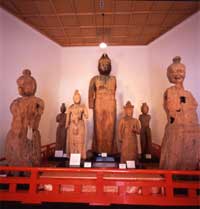
| Pseudonym reading | Other than the above |
|---|---|
| Specified type | Prefecture designation |
| Type | Sculpture |
| Designated date | February 15, 1974 |
| Specified details | |
| quantity | |
| location | Tamayama-ji, Tamayama-ku, Morioka City |
| owner | Torakuji Temple |
| Holding group | |
| Management organization | |
| home page |
Overview
Wooden statue of Ninou (2 bodies) Attached to a wooden 11-faced statue of Guanyin (5 bodies) Attached to a wooden statue (1 body) A statue of Nioh has two bodies, an opening (A) and a closing (吽).
Opening image height 218.7 cm.
Image height 203.0 cm.
Both statues are wooden, Katsuragi and wooden.
The inside was given from the back, and the cut back member was scraped off to make a back plate.
(Now deleted) The production age is considered to be the Heian period.
The eleven statues of Kannon Zen statues have a wooden statue of No. 1 with an image height of 190.0 cm.
No. 2 Image height 176.0 cm, wooden, Katsura.
No. 3 Image height 130.0 cm, wooden, bare wood.
No. 4 Image height 164.0 cm, wooden, bare wood.
No. 5 177.0 cm tall, wooden, Katsura.
No. 6 image height 88.0 cm, wooden, Katsura wood (attached wooden standing statue).
All are 11 wooden statues of the 11th and 11th, and only 11 are left. The other is estimated to be 11th from the number of pattern holes on the treasure hair.
The production age is considered to be the Heian period.
From Dou, whose principal image is the 11th Kannon statue, located in Nishio, Morioka city, both the Nioh statue and the 11th Kannon are the Himejindake Shrine Kannon Hall in Tamayama Ward, Morioka City, during the Shonan Period (1644 to 1647) It was transferred to Tohaku-ji Temple as of 1927 (1927).
